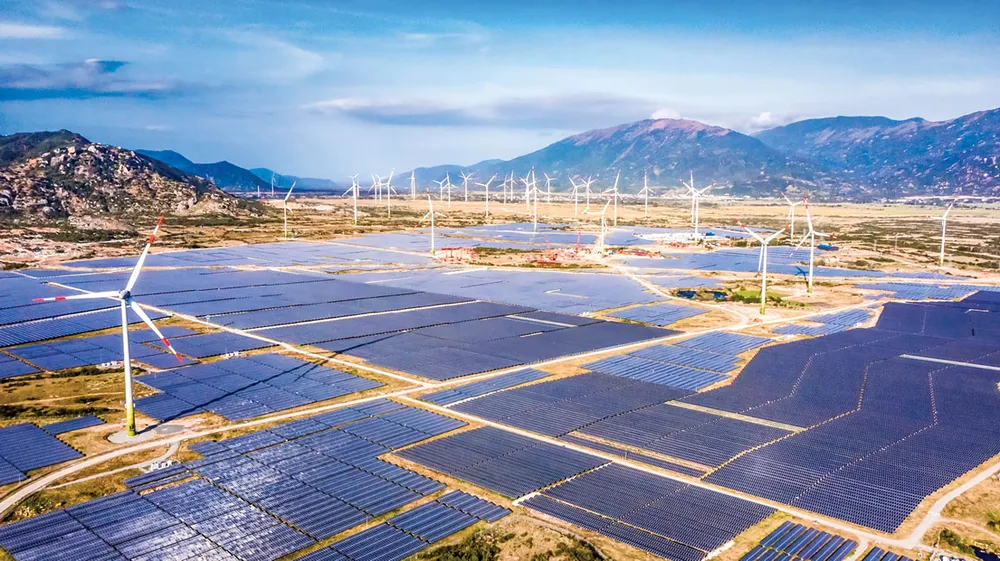
However, because of unclear procedures and regulations, these renewable energy corporate bonds can also suddenly plummet, same as in the earlier traffic corporate bonds market.
Hot growth momentum
According to statistics from the Vietnam Bond Association and a number of other securities companies, in the first three quarters of 2021 alone, energy enterprises mobilized nearly VND 22,000 bn in corporate bonds. In the fourth quarter of 2021, although the bonds of renewable energy enterprises had somewhat slowed down when the banking group began to dominate the market, it still maintained a strong growth momentum. In 2021, the issuance of corporate bonds led by the Trung Nam Group, and then followed by Gia Lai Electricity JSC (GEG), had very high interest rates, ranging from 9.5% to 11% per year. This led to the issuance of Renewable Energy Bonds by businesses in this field. All these bonds also sold out very fast.
The fact is that all investment opportunities in the green energy sector are very large, and the Government aims to cut down on polluting power sources, especially after Vietnam's commitment at the COP26 Conference on climate change. Besides this, according to the draft Power Plan VIII currently being submitted to the Government by the Ministry of Industry and Trade, the contribution of renewable energy sources towards increasing the power in the future will account for 40.6% of the total capacity of power resource in the country by 2045. In this, wind power and solar power will be the main driving force, while biomass and small hydroelectricity with capacity below 30MW will account for a lesser or quite a negligible proportion.
The main point in the draft Power Master Plan VIII is to reduce coal power and strongly encourage the development of renewable energy and new green energy. In the field of renewable energy, it is necessary to ensure system efficiency and balance. In particular, offshore wind power plays an important role and will be prioritized in coming time. This has encouraged investors to pour in more funds into buying Renewable Energy Bonds of various companies as soon as they are issued in the market.
It is estimated that the capital needed to implement Renewable Energy projects in the next three to five years will be about USD 50 bn to 70 bn. The current banking system is unable to manage this huge amount, so investors have to call for capital through corporate bonds. Therefore, there are also concerns that energy enterprises are using high interest rates for corporate bonds as a way to entice investors and mobilize more capital, while also concealing their true financial capacity. This is like a double-edged sword when all capital invested by investors is entrusted to enterprises that cannot offer any guarantees. In the current hot growing corporate bonds market, investors, and in particular individual investors, have no way or buffer against unexpected risks. Besides, the credit capacity of the issuer and the bond interest rate is also increasing.
This situation can prove to be potentially volatile for both sides. For energy enterprises it is difficult to optimize the cost of capital by issuing bonds at such high interest rates because investment in renewable energy projects takes a long time, as the pricing for end product is still unclear, so the risk is much higher. For the investors, they are also struggling because of lack of appraisal and information. While banks have carefully appraised renewable energy projects, individual investors who buy corporate bonds mainly look at the interest rates of bonds issued by the issuer, and do not know which bonds are safe or profitable beforehand.
No procedural system
The surge in the development of corporate bonds in the renewable energy sector is growing but the procedural system is still not clear, which is affecting the profitability and debt repayment ability of investors, thereby posing risks to the fund flow of banks and investors. One of the big risks of renewable energy projects is the long and lengthy investment period. For example, in 2021, many wind power projects of scale of trillions of dong were in a difficult position, when the site clearance was not completed due to the outbreak of the Covid-19 pandemic have caused delays in equipment transportation, difficulty for foreign experts to enter the country, and the factories facing delays in starting time. This affected the efficiency of investment capital, and businesses were forced to bear high interest costs after issuing mobilized bonds.
According to experts, the unclear electricity price level is the biggest risk for investors buying energy corporate bonds, as well as for banks and investors of renewable energy projects. Currently, many larger capacity renewable energy projects are receiving investments, but this could become even more problematic. Recently, there have been warnings that after the phase of introducing projects and raising capital, there will be a period of calm and quiet for renewable energy enterprises, when they will be compelled to face a set of strict regulations. At this stage, investors will see profit margins fall and may even become discouraged and even think about giving up.
Such warnings are not unfounded. Currently, there is still a large gap in legislation and policies from FIT for the application of a new electricity pricing system. While there are opinions that the current selling price of electricity for production is lower than in many other developing countries, it is essential to adjust the electricity price reasonably. A reasonable price level will support production and businesses and encourage the development of renewable energy. Up until now, there is still no clear solution being offered by the Ministry of Industry and Trade.
There are serious concerns that the current hot growth rate of corporate bonds in the renewable energy sector may likely be a repeat of failure in projects of transport enterprises in previous years. The BOT projects are typical examples of failure.




















